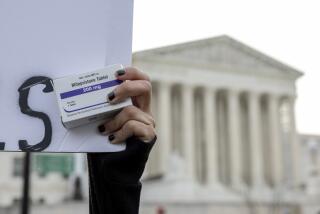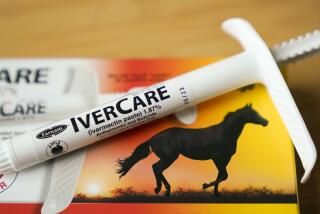A warning label warning
- Share via
It’s hard to imagine a more sympathetic victim than Diana Levine, a guitarist who lost her arm to gangrene after she was negligently injected with Phenergan, an anti-nausea drug. Last week, the Supreme Court by a 6-3 vote upheld a Vermont jury’s decision that Wyeth, the manufacturer of the drug, should pay Levine nearly $7 million because the label on the drug didn’t adequately warn medical personnel about the risk of a particular method of injection.
The justices were right to rule for Levine, but not because of the poignancy of her situation. If the court wanted to compensate every victim of a medical procedure gone wrong, it wouldn’t have ruled 8 to 1 last year against a patient who was injured when a catheter ruptured in his coronary artery during heart surgery. The issue in that case, as in Levine’s, was whether the federal government clearly had prohibited state regulation of medical products.
In the case of the catheter, the court said yes, pointing to a 1976 law that prohibits states from establishing any safety requirement for medical devices “which is different from, or in addition to, any requirement applicable under [federal law].” In Levine’s case, Justice John Paul Stevens wrote for the majority that federal law regulating pharmaceuticals was not intended to preempt state law requiring adequate warnings of the dangers of some drugs.
The legal differences between the two cases obscure the political question underlying both. Under the Constitution, Congress has the authority to regulate interstate commerce and is able to prevent the states from adopting their own regulations -- a power Congress sometimes for good reasons chooses not to exercise. A familiar example is a provision of the Clean Air Act allowing California to seek a waiver from national air pollution standards in order to impose tougher requirements.
Should states be similarly free to adopt their own standards for warning labels for drugs and medical devices? And should those standards be set by state agencies or by juries, as in the Levine lawsuit? We would answer “no” to both questions. Medical care ought to be governed by a national standard. Even if one favors additional state regulation, juries in individual cases within a state can come to wildly different conclusions about whether a warning label is adequate.
That said, if Washington doesn’t aggressively protect public health, states will try to. Drug companies shouldn’t have to comply with potentially 50 separate requirements for warning labels. But the best way for them to avoid that complication is to join with Congress and the Food and Drug Administration in making sure that warnings are unambiguous and up to date.
More to Read
A cure for the common opinion
Get thought-provoking perspectives with our weekly newsletter.
You may occasionally receive promotional content from the Los Angeles Times.










